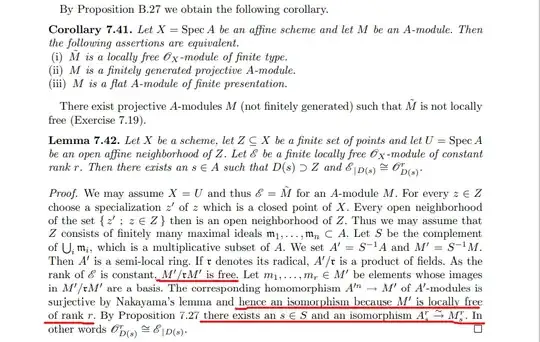I am reading the Gortz's Algebraic Geometry, p.195, Lemma 7.42 and trying to understand some statements :
( Note (Errata) : In the proof, $A'^{r} \to M'$ is more correct instead of $A'^{n} \to M'$ and $ A_s^{r} \cong M_s$ is more correct instead of $A_s^{r}\cong M_s^{r}$. )
Throughout question, we will use the Corollary 7.41 (i) => (ii) in the above image.
First, for the second underlined statement, can we prove even "freeness of $M' = S^{-1}M$ of rank $r$", instead of the "local freeness of rank $r$"? Reason that I claim this is, since $M'$ is viewed as an $A'$-module and $A'$ is a semi-local ring, we may apply the answer of 'wxu' in next linked question : How can I find an element $x\not\in\mathfrak mM_{\mathfrak m}$ for every maximal ideal $\mathfrak m$ ? Is there something that I'm mistaken? If we can show the freeness of $M'$ (of rank $r$), then we can use A surjective homomorphism between finite free modules of the same rank to show that $A'^{r} \to M'$ is an isomorphism.
Or if not, is there any other method to show that $A'^{r}\to M'$ is isomorphism just from the local freeness of $M'$ of rank $r$?
Second. let's see the first underlined statement. Assume that we can prove that $M'$ is free over $A'$ of rank $r$. Then even if this statement is true, doesn't it guarantee the freeness of $M'/\tau M'$ over $A'/\tau $? So he detours through noting that "$A'/\tau$ is a product of fields" and shows the freeness of $M'/\tau M'$? (c.f. Every $A$-module is projective if and only if $A$ is a finite direct product of fields. )
Thrid, for the final underliend statement, at last, we have an isomorphism $(S^{-1}A)^{r} = A'^{r} \xrightarrow{\cong} M' = (S^{-1}M)$ Form this, how to show the existence of $s \in S$ and an isomorphism $A_s^{r} \xrightarrow{\cong} M_s$? Proposition 7.27 in the proof is as follows :
Thanks for reading. Can anyone help?

